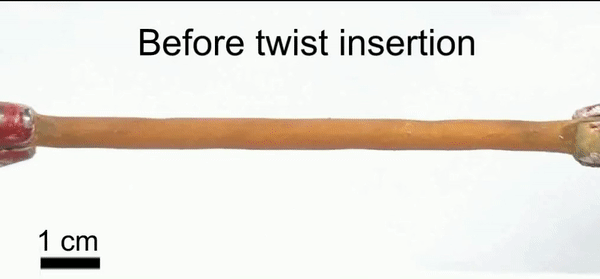Research shows that doing the twist is hot, unwinding is cool

An international team led by researchers at The University of Texas at Dallas and Nankai University in China has discovered a new technology for refrigeration that is based on twisting and untwisting fibers.
In research published in the Oct. 11 issue of the journal Science, they demonstrated twist-based refrigeration using materials as diverse as natural rubber, ordinary fishing line and nickel titanium wire.
"Our group has demonstrated what we call 'twistocaloric cooling' by changing the twist in fibers. We call coolers that use twist changes for refrigeration 'twist fridges,'" said Dr. Ray Baughman, director of the Alan G. MacDiarmid NanoTech Institute at UT Dallas. Baughman is a corresponding author of the study, along with Dr. Zunfeng Liu, a professor in the State Key Lab of Medicinal Chemical Biology in the College of Pharmacy at Nankai University in Tianjin.
The Quest for New Technologies
According to the International Institute of Refrigeration, refrigeration and air conditioning consume about 20% of global electrical energy. Conventional refrigerators also release gases that significantly contribute to global warming.
As consumption continues to grow, especially due to the increasing needs of developing nations, researchers are investigating alternative cooling technologies to increase refrigeration efficiency, lower costs and reduce size.
Stretching a rubber band heats the rubber, and releasing the stretch cools it: This is called elastocaloric cooling. Other solid substances for cooling include electrocaloric and magnetocaloric materials, which cool via changes in electric and magnetic fields, respectively.
"This elastocaloric behavior of natural rubber has been known since the early 1800s. But to get high cooling from a rubber band, you have to release a very large stretch," Baughman said. "With twistocaloric cooling, we found that all you have to do is release twist."
The Experiments
Baughman's research teams previously developed artificial muscles made by tightly twisting and coiling fibers that range from carbon nanotube yarns to ordinary nylon thread and polyethylene fishing line.
In the current work, the scientists stretched rubber fibers, then twisted them until they not only coiled, but also supercoiled. Fast release of the twist resulted in surface temperature cooling of 15.5 degrees Celsius. Releasing both the twist and the stretch from the rubber produced even higher cooling of 16.4 degrees Celsius.
The twistocaloric cooling also worked for fishing line. The researchers inserted twist into nonelastic polymer fishing line until coils formed. Stretching the coiled fiber caused heating, while stretch release produced a maximum surface cooling of 5.1 degrees Celsius.
"By employing opposite directions of twist and coiling, we engineered fibers that cool when stretched," said Baughman, the Robert A. Welch Distinguished Chair in Chemistry in the School of Natural Sciences and Mathematics. "This is quite unusual behavior since ordinary materials heat up when stretched."
To investigate the origin of the cooling effect in the fishing line, the researchers turned to X-ray crystallography, which allowed them to determine what was happening on the molecular level when twist was changed by stretching a coiled fiber.
"We found that releasing stretch from a coiled fiber results in partial conversion of a low entropy phase into a high entropy phase," Liu said. "This phase change causes twistocaloric cooling."
Potential Applications
Large reversible cooling was also achieved by removing twist from nickel titanium wires and by unplying bundles of these wires. A maximum surface cooling of 17 degrees Celsius was observed when the researchers untwisted a single wire. Unplying a four-wire bundle produced even higher cooling of 20.8 degrees Celsius.
The researchers placed a three-ply nickel titanium wire cable in a device they built that cooled a stream of water by up to 7.7 degrees Celsius when the cable was unplied. "By using further cycles of twist and twist release, much higher cooling can be achieved," Liu said.
In another set of experiments, they coated the different types of fibers with thermochromic paint, which changes color in response to temperature variations produced by twisting fibers or stretching coiled fibers. Such fibers could be used for remotely readable sensors of strain and twist, as well as for color-changing textiles for clothing.
"Many challenges and opportunities exist on the path from these initial discoveries to commercialization of twist fridges for diverse large- and small-scale applications," Baughman said. "Among the challenges are the need to demonstrate refined devices and materials that provide application-targeted cycle lifetimes and efficiencies by recovering part of the inputted mechanical energy. The opportunities include using performance-optimized twistocaloric materials, rather than the few presently studied commercially available candidates."
Torsional refrigeration by twisted, coiled, and supercoiled fibers
Wang R, Fang S, Xiao Y, Gao E, Jiang N, Li Y, Mou L, Shen Y, Zhao W, Li S, Fonseca AF, Galvão DS, Chen M, He W, Yu K, Lu H, Wang X, Qian D, Aliev AE, Li N, Haines CS, Liu Z, Mu J, Wang Z, Yin S, Lima MD, An B, Zhou X, Liu Z, Baughman RH
Science 11 Oct 2019: Vol. 366, Issue 6462, pp. 216-221
Contact information:
Ray Baughman
Professor of Chemistry at UT Dallas
Phone: 972-883-6538
University of Texas at Dallas (UT Dallas)












